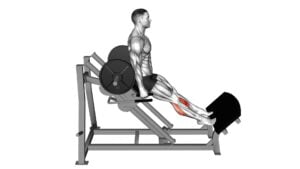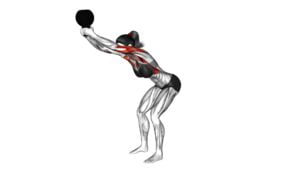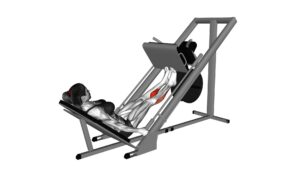Sled Angled Single Leg Press (female) – Video Exercise Guide & Tips

Are you looking to strengthen and tone your legs? Then the sled angled single leg press is the exercise for you!
Watch This Exercise Video
In this video exercise guide, we'll show you the proper form and technique to maximize your results. You'll also discover variations and modifications to challenge yourself and avoid common mistakes.
Whether you're a beginner or a seasoned fitness enthusiast, incorporating the sled angled single leg press into your workout routine will take your leg training to the next level.
So let's get started!
Key Takeaways
- Sled angled single leg press targets and strengthens leg muscles effectively, including the glutes, quadriceps, hamstrings, and calves.
- The angled position allows for a greater range of motion and muscle recruitment, leading to increased muscle activation, strength, and development in the legs.
- This exercise improves balance and stability, which is crucial for performance and injury prevention.
- Incorporating variations and modifications, such as wide or narrow stances, single arm press, or elevated sled, can provide variety and target different muscle groups.
Benefits of Sled Angled Single Leg Press
One key benefit of the sled angled single leg press is that it targets and strengthens the muscles in your legs more effectively than traditional leg press exercises. This exercise specifically activates the muscles in your glutes, quadriceps, hamstrings, and calves. The angled position of the sled allows for a greater range of motion, which activates more muscle fibers and increases muscle recruitment. This increased muscle activation leads to improved strength and muscle development in the legs.
In addition to targeting specific leg muscles, the sled angled single leg press also helps improve balance and stability. Since this exercise is performed unilaterally, meaning one leg at a time, it requires greater stabilization and control. By engaging your core and stabilizer muscles, you can enhance your overall balance and stability. This is especially beneficial for athletes, as balance and stability are crucial for performance and injury prevention.
Proper Form and Technique for Sled Angled Single Leg Press
To perform the sled angled single leg press correctly, position yourself on the sled with one foot firmly planted on the foot plate. Make sure your knee is aligned with your ankle and your hip is at a 90-degree angle. Keep your back straight and engage your core for stability. Grab the handles on the side of the sled for support.
As you begin the exercise, push through your planted foot to extend your leg, driving the sled away from you. Maintain control and avoid locking out your knee at the top of the movement. Slowly return to the starting position by bending your knee and bringing the sled back towards you.
When performing the sled angled single leg press, it's important to focus on proper form and technique to maximize results and prevent injury. By maintaining control throughout the exercise and engaging the targeted muscle groups, you can effectively strengthen your quadriceps, hamstrings, glutes, and calf muscles.
While the sled angled single leg press is a great exercise, there are alternatives you can try to target similar muscle groups. Some alternatives include the squat, lunge, step-up, and leg press machine exercises. Incorporating these exercises into your routine can help add variety and challenge your muscles in different ways.
Remember to always consult with a fitness professional before attempting new exercises to ensure proper form and technique.
Variations and Modifications for Sled Angled Single Leg Press
To modify the sled angled single leg press, you can adjust the angle of the sled or increase the weight for a greater challenge. Here are some variations and modifications you can try to target different muscle groups and intensify your workout:
- Wide Stance: Place your feet wider apart on the sled to engage your inner thighs more.
- Narrow Stance: Bring your feet closer together on the sled to target your outer thighs and glutes.
- Single Arm: Instead of using both arms to push the sled, try using just one arm at a time to challenge your core stability and unilateral strength.
- Elevated Sled: Elevate the sled by placing a step or platform underneath it. This will increase the range of motion and engage your muscles differently.
By incorporating these variations and modifications into your sled angled single leg press routine, you can add variety to your workouts and continue challenging your muscles in new ways. Keep in mind that it's important to maintain proper form and technique throughout the exercise to prevent injury and maximize effectiveness.
Now, let's move on to the next section where we'll discuss common mistakes to avoid during sled angled single leg press.
Common Mistakes to Avoid During Sled Angled Single Leg Press
Are you making any of these common mistakes during the sled angled single leg press? Proper form and technique are crucial for maximizing the benefits of this exercise and preventing injuries.
One common mistake is using too much weight. It's important to start with a weight that allows you to maintain proper form throughout the movement. Using excessive weight can lead to compensations and compromise the effectiveness of the exercise.
Another mistake isn't maintaining a stable core. Your core muscles play a vital role in stabilizing your body during the exercise. Failing to engage your core can put unnecessary strain on your lower back and increase the risk of injury.
Additionally, avoid rushing through the exercise. Take your time to perform each repetition with control and focus on maintaining proper alignment.
Lastly, make sure your foot placement is correct. Your foot should be positioned in the center of the sled platform, with your knee aligned over your ankle. Avoid placing your foot too high or too low, as this can lead to improper biomechanics.
Tips for Incorporating Sled Angled Single Leg Press Into Your Workout Routine
How can you effectively incorporate the sled angled single leg press into your workout routine? Here are some tips to help you make the most of this exercise:
- Start with proper form: Position yourself on the sled at a 45-degree angle, with one leg on the platform and the other extended in front of you. Keep your back straight and engage your core throughout the movement.
- Gradually increase weight: Begin with a lighter weight and gradually increase as you become more comfortable and confident with the exercise. This will help you avoid injury and ensure that you're challenging yourself appropriately.
- Incorporate plyometric exercises: To further enhance the benefits of the sled angled single leg press, you can incorporate plyometric exercises into your routine. For example, after completing a set of presses with one leg, immediately switch to the other leg and perform a jump squat. This combination of strength and explosiveness will help improve your power and athleticism.
- Embrace the benefits of unilateral training: Unilateral training, which focuses on one side of the body at a time, can help correct muscle imbalances and improve overall stability. By incorporating the sled angled single leg press into your routine, you're specifically targeting each leg individually, which can lead to more balanced strength and improved performance in other exercises.
Frequently Asked Questions
How Much Weight Should I Start With When Doing the Sled Angled Single Leg Press?
When starting the sled angled single leg press, it's important to find the right weight for you. Begin with a weight that challenges you but allows you to maintain proper form.
If you have knee injuries, consider reducing the weight or modifying the exercise to avoid any discomfort.
As you progress, gradually increase the weight to continue challenging yourself. Remember to listen to your body and consult with a trainer or healthcare professional for personalized advice.
Can I Do the Sled Angled Single Leg Press With an Existing Knee Injury?
If you have an existing knee injury, it's important to modify your workout routine to avoid further damage.
The sled angled single leg press may not be the best exercise for you in this case.
However, there are alternative exercises that can still target your leg muscles without putting excessive strain on your knees.
It's always recommended to consult with a professional or physical therapist to determine the most suitable exercises for your specific injury.
Is the Sled Angled Single Leg Press Suitable for Beginners?
The sled angled single leg press can be suitable for beginners with some modifications. It's important to start with lighter weights and focus on proper form to avoid injury.
Incorporating this exercise into your routine can have great benefits such as strengthening your leg muscles, improving balance, and enhancing overall lower body strength. Gradually increase the weight as you become more comfortable and confident.
Consult with a fitness professional for guidance on proper technique and modifications for beginners.
How Often Should I Include the Sled Angled Single Leg Press in My Workout Routine?
To optimize your workout routine, it's important to include unilateral exercises like the sled angled single leg press. Incorporating unilateral exercises helps improve balance, stability, and strength on each side of your body.
As for how often you should include this exercise, it depends on your fitness goals and overall program. Start with 2-3 times a week and gradually increase frequency and intensity as you progress.
Consult with a fitness professional for personalized guidance to achieve optimal results.
Can I Perform the Sled Angled Single Leg Press Using a Different Machine or Equipment?
Yes, you can perform the sled angled single leg press using different machines or equipment. There are alternative options available such as the leg press machine or resistance bands. These modifications allow you to target your muscles effectively while adapting to your fitness level.
It's important to choose equipment that provides a similar range of motion and resistance as the sled angled single leg press for optimal results.
Conclusion
Incorporating the sled angled single leg press into your workout routine can provide numerous benefits, such as increased lower body strength and stability.
By maintaining proper form and technique, you can effectively target the muscles in your legs and glutes.
It's important to avoid common mistakes, such as using too much weight or lifting with your back, to prevent injury.
With variations and modifications available, this exercise can be tailored to meet your specific fitness goals.

Author
Years ago, the spark of my life’s passion ignited in my mind the moment I stepped into the local gym for the first time. The inaugural bead of perspiration, the initial endeavor, the very first surge of endorphins, and a sense of pride that washed over me post-workout marked the beginning of my deep-seated interest in strength sports, fitness, and sports nutrition. This very curiosity blossomed rapidly into a profound fascination, propelling me to earn a Master’s degree in Physical Education from the Academy of Physical Education in Krakow, followed by a Sports Manager diploma from the Jagiellonian University. My journey of growth led me to gain more specialized qualifications, such as being a certified personal trainer with a focus on sports dietetics, a lifeguard, and an instructor for wellness and corrective gymnastics. Theoretical knowledge paired seamlessly with practical experience, reinforcing my belief that the transformation of individuals under my guidance was also a reflection of my personal growth. This belief holds true even today. Each day, I strive to push the boundaries and explore new realms. These realms gently elevate me to greater heights. The unique combination of passion for my field and the continuous quest for growth fuels my drive to break new ground.



